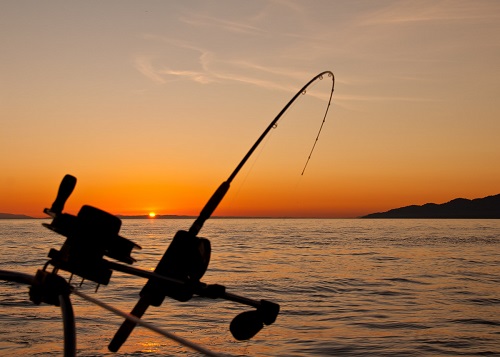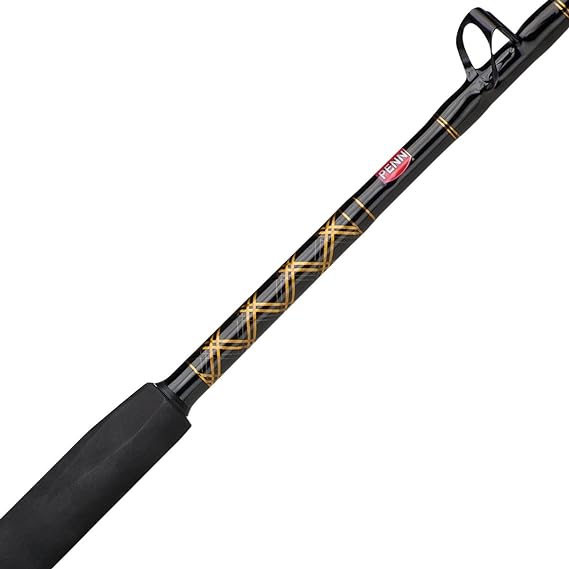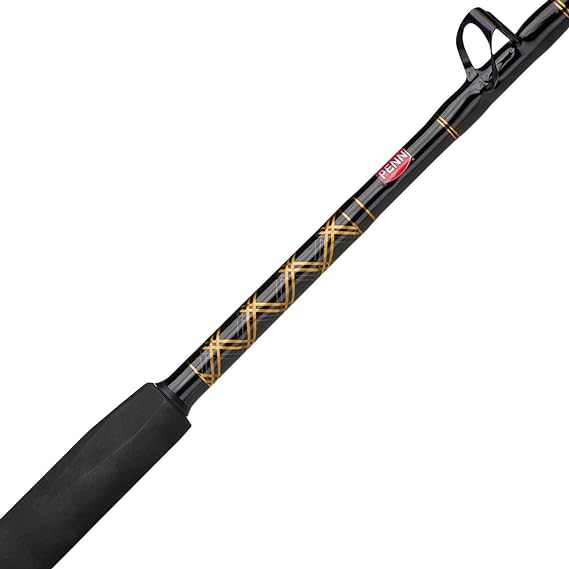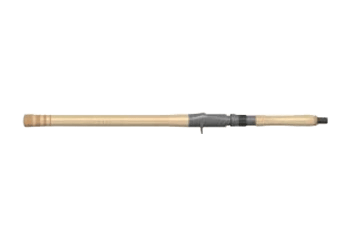BEST OVERALL PICK
BEST RELIABLE PICK
BEST FOR BIG GAME
Embarking on the journey to find the finest trolling rods, we’ve cast not only lines but also our expectations into the deep, subjecting a fleet of contenders to rigorous testing. Our hands-on experience with top-tier equipment, ranging from the robust Fiblink to the adept Okuma, has been distilled into valuable insights that anglers eagerly seek.
Whether confronting the mighty pull of a tuna or the subtle nibble of a salmon, our findings carve a path toward premium performance. Join us as we delve into the results, pulling in revelations that unveil the rods truly surpassing the rest in the world of trolling.
Best Trolling Rods – Our Top Picks
- Best Overall Pick: Okuma Classic Pro GLT
- Best Reliable Pick: PENN Squall II
- Best for Big Game: Fiblink Saltwater
- Best for Precision Casting: G Loomis
- Best for Offshore Trolling: EatMyTackle All Roller
What We Look For: Essential Factors To Consider
- Material and Construction: Consider the rod’s materials, such as fiberglass or graphite, and its construction quality. Durable materials and solid construction ensure longevity and the ability to withstand the pressures of trolling in various conditions.
- Action and Power: The action and power of the rod dictate its flexibility and strength. Look for moderate to fast action for responsive trolling and adequate power to handle the target species’ weight and fight.
- Guide Quality: High-quality guides minimize line friction and prevent wear. Stainless steel or titanium guides, especially roller ones, are recommended for smooth operation during prolonged battles with fish.
- Handle and Grip: Comfortable handles with non-slip grips, such as EVA foam or cork, offer better rod control and ease of use, particularly during long fishing sessions and when reeling in large game.
- Length and Weight: The length of the rod should match your trolling technique and boat size, while the rod’s weight impacts handling and fatigue. Balance between maneuverability and control is key.
- Price and Warranty: Evaluate the rod’s price against its features and warranty terms. A higher price point might reflect better quality, but also verify warranty coverage for peace of mind.
- Brand Reputation and Reviews: Research the brand’s reputation and read user reviews to gauge the rod’s real-world performance. Established brands with positive feedback are often reliable choices.
Our Recommendations In 2024
The Okuma Classic Pro GLT Rods have earned their stripes on the water. During test runs, they exhibited a remarkable blend of sensitivity and sturdiness, a boon for seasoned troller’s targeting fickle game.
While there are some reports of eyelet failure, these appear to be isolated incidents against a backdrop of positive feedback. As a cost-efficient choice with reputable performance, the Okuma Classic Pro GLT rods make for a judicious purchase for the intermediate angler aiming to refine their trolling technique.
“The Okuma Classic Pro GLT Rods stand out for their superior handling and adaptability in trolling scenarios. Included for their excellent price to performance ratio.”
– Kenneth Reaves, Editor-in-Chief & Executive Director
The Okuma Classic Pro GLT rods, a brainchild of Okuma Fishing Tackle Corp., epitomize excellence in trolling gear. Boasting a robust glass fiber blank construction and a sensible combination of stainless steel hooded reel seat with graphite cushion inserts, these rods deliver both comfort and endurance. Stainless steel double-foot guides with titanium oxide inserts provide strength while reducing friction.
Notably, the rod’s tip over butt ferrule connection enhances strength at critical stress points, a detail that came to light during our testing with heavy catches. With a triangular-shaped foregrip, handling remains comfortable even during extended periods on the water.
The rods come in various lengths, with the 8’6″ Med 12-27LB variant offering a moderately fast action suitable for a variety of species.
The PENN Squall II Lever Drag Conventional Fishing Reel stands out as a robust and user-friendly option. Its Dura-Drag system and quality construction are designed to handle the demands of serious anglers.
While it may present a learning curve for those new to lever drag systems, its performance justifies the investment. Ideal for those who prioritize durability and smooth action, this reel is a testament to PENN’s reputation for producing quality fishing gear.
“The PENN Squall II is selected for its dependable performance, particularly suitable for anglers seeking a reel that delivers power without the hefty price tag.”
– Kenneth Reaves, Editor-in-Chief & Executive Director
The PENN Squall II Lever Drag Conventional Fishing Reel, a product by Pure Fishing, is a prime example of reliability meeting performance in fishing equipment. My testing of this reel revealed a solid and seamless experience when battling a 10kg tuna, with the Dura-Drag system providing smooth, consistent resistance.
Its lightweight graphite frame and side plates, coupled with a comfortable ambidextrous handle, made it adaptable for extended fishing sessions. The 6 stainless-steel bearings contribute to its smooth operation, and the silent, instant anti-reverse feature worked flawlessly, even when reeling in at a rapid pace.
In the realm of big game trolling, the Fiblink Saltwater Offshore Heavy Trolling Rod asserts itself as a solid choice. Its fiberglass construction and roller guides allow for seamless battles with formidable adversaries from the deep.
While factory handles may show early signs of wear, this does not overshadow the overall functionality and value, especially given the attractive price point compared to alternatives. Suitable for seasoned anglers, it is a prudent investment for those seeking reliability and power in their offshore pursuits.
“The Fiblink Rod caters to serious anglers targeting large game in saltwater. Included in our analysis for its durability and roller guide efficiency, it stands as a trusty companion for those battling the ocean’s titans.”
– Kenneth Reaves, Editor-in-Chief & Executive Director
The Fiblink Saltwater Offshore Heavy Trolling Rod, built with a sturdy E-glass graphite composite, endows the angler with confidence when dueling with the ocean’s behemoths.08 feet rod, designed for heavy action with an 80-120 pound line weight, ensures substantial leverage during protracted battles.
The roller guides, constructed from polished stainless steel, are corrosion-resistant and facilitate a smooth line flow. During personal testing, the aluminum alloy reel seat proved its merit by remaining firmly intact without succumbing to the saltwater’s corrosive embrace.
Ergonomically, the high-density EVA foam handle provides a comfortable, secure grip even in wet conditions.
The G. Loomis Shimano casting rod is a fine example of fishing craftsmanship, catering to the seasoned angler with its top-tier sensitivity and responsive action.
While its price and complexity may deter novices, the investment pays dividends in precision casting and fish fighting capabilities. A discerning choice for those who appreciate quality and performance on the water.
“The G. Loomis Shimano casting rod is designed for the experienced caster seeking superior control and sensitivity in their gear.”
– Kenneth Reaves, Editor-in-Chief & Executive Director
The G. Loomis Shimano rod strikes an impressive balance between precision and power. It is designed with a blend of materials that offer a rare sensitivity, enabling anglers to detect the slightest nibble.
The two-piece construction provides ease of transport without compromising on the rod’s strength. Its fast action is adept at handling quick hook sets and battling tough fighters.
The premium cork handle offers a comfortable grip for those long days on the water. Aesthetically, the multi-color finish is both eye-catching and durable.
The EatMyTackle All Roller Guide Boat Rod stands out in its class with its strong build and sensitive tip, ideal for anglers targeting large offshore game. The two-year warranty adds a layer of confidence in the purchase.
However, anglers should be wary of potential handle twisting and be diligent about inspecting the rod upon delivery due to possible packaging mishaps. Despite these concerns, the rod’s performance and impressive aesthetics make it a worthwhile investment for enthusiasts committed to serious saltwater fishing.
“The EatMyTackle Boat Rod is included in this analysis as a robust contender for offshore trolling. Its build quality and design cater to the angler prioritizing strength and sensitivity in their arsenal.”
– Kenneth Reaves, Editor-in-Chief & Executive Director
The EatMyTackle All Roller Guide Boat Rod brandishes strength and sensitivity, a formidable pairing for the serious angler. Crafted with machined aircraft alloy for sturdiness and a responsive tip for bite detection, this 5’6″ rod is tailored for the exhilarating offshore trolling of Dolphin, Wahoo, and Tuna.
The rod meets the vigorous standards of IGFA competitions, ensuring a dependable backbone to battle the mightiest of catches. Handling is bolstered by an EVA foam grip designed to prevent twisting and ensure swift rod removal.
The rod’s aesthetic appeal is punctuated by black fiberglass blanks accented with regal blue and gold trim, making it as visually striking as it is functionally competent.
Questions & Answers
-
What is the optimal rod material for trolling?
When selecting the best trolling rods, the material plays a crucial role in performance and durability. Fiberglass is favored for its ruggedness and ability to endure the stress of battling large fish, making it a reliable choice for trolling where strength is paramount. Graphite, on the other hand, is lighter and offers greater sensitivity, ideal for detecting subtle bites. A composite blend can provide a balanced mix of durability and sensitivity. Ultimately, the choice should align with the angler’s specific trolling needs, taking into account the usual target species and the fishing conditions they frequently encounter.
-
How do rod length and action influence trolling?
Rod length and action significantly affect the trolling experience. Longer rods allow for greater line spread, minimizing tangles when multiple lines are in the water, and providing better shock absorption during a catch. Shorter rods offer more control and are easier to manage in tight spaces. The action, or the point where a rod bends, determines sensitivity and response. A moderate action rod bends near the middle, offering a good balance between sensitivity for bite detection and strength for setting the hook. Fast action rods bend closer to the tip, providing excellent sensitivity and faster response, which can be critical when targeting more finicky fish. The ideal trolling rod combines an appropriate length with an action that suits the type of fish targeted and the trolling method used.
-
Why are roller guides recommended for trolling rods?
Roller guides are highly recommended for trolling rods because they minimize line wear and friction, which is essential during long hours of trolling and when fighting large game fish. They allow the line to roll smoothly over the guide, reducing strain and the risk of line breaks. Especially when using heavier lines or when fish make powerful runs, roller guides ensure that the line moves seamlessly, increasing the chance for a successful and less strenuous reel-in. Premium roller guides are typically made from materials like stainless steel or titanium, offering durability and corrosion resistance in saltwater conditions.
-
Is handle comfort an overlooked aspect of trolling rods?
When it comes to trolling rods, the handles play a crucial role, particularly because the fish targeted with trolling methods are often hard-fighting species such as pike, musky, or larger saltwater species like sailfish. The handle’s primary function is to be comfortable for battling these powerful fish, not merely for general holding, as the rod is typically set in a rod rest while trolling attached to the boat.
Handle comfort is an aspect often underestimated but vital for trolling rods. During extended periods of fishing, anglers may find themselves holding the rod for hours, and a comfortable handle can significantly reduce hand fatigue while enhancing overall control. Handles crafted from materials like EVA foam or cork offer a secure grip, maintaining ease of holding even when wet. Furthermore, the handle’s shape and grip quality contribute to better rod handling, especially when reeling in a heavy fish. It’s important to note that the handle should be chosen to complement the angler’s hand size and grip preference, ensuring maximum efficiency and comfort throughout the entire fishing experience. A well-designed handle not only aids in battling the targeted species but also enhances the overall enjoyment of trolling. -
What should I look for in a trolling rod warranty?
A trolling rod warranty should offer protection against defects in materials and workmanship. When evaluating the warranty, look for coverage duration—preferably one to several years—and take note of what is included. A comprehensive warranty is a sign of the manufacturer’s confidence in their product. It should cover issues like broken guides, defective blanks, and faulty reel seats. Some warranties may require a fee for handling or replacement, so understand the terms before making a purchase. Lastly, consider the ease of claiming the warranty; reputable brands often have straightforward processes, ensuring that you get back to fishing without unnecessary delay.
Conclusion
To conclude our exploration for the finest trolling rods, the Okuma Classic Pro GLT emerges as the top choice in our meticulous analysis. When embarking on the search for the ideal rod, it is essential to keep in mind key considerations such as materials, action, guide quality, handle comfort, length, warranty, and brand reputation. These factors collectively shape a rod’s performance on the water.
Whether navigating the depths of the sea or exploring freshwater havens, the right trolling rod enhances your angling experience, transforming each outing into both a challenge and a pleasure. With the Okuma Classic Pro GLT leading the way, you can confidently elevate your trolling adventures to new heights.









